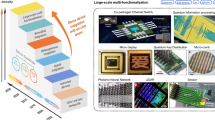Abstract
RF circuits play a vital role in high data rate communication systems. Although at the design stage several considerations are made to ensure that the designed circuit functions as per desired specifications, the effect of process variations on the circuit’s performance is less understood. The parametric variations arising from the various stages of fabrication play a significant role in determining the device characteristics. In this paper, in order to analyze the effect of process variations, we consider a bottom–up approach beginning at the component level for active and passive elements and then move to the circuit level in an RF circuit consisting of both analog and digital components. We take Low Noise Amplifier (LNA) and a Phase Frequency Detector (PFD) which is one of the important building blocks of a Phase Locked Loop (PLL) as case studies for circuit level analysis. In the case of LNA, the performance is analyzed in terms of the S-parameters, gain and Noise Factor on different topologies and for a PFD, an analytical model is developed and the analysis is carried out using the Monte Carlo method to verify the robustness of the circuit elements towards phase noise. Our hierarchical multi-phase analysis technique is shown to provide valuable insights into designing robust RF circuits.


















Similar content being viewed by others
References
Agarwal A, Blaauw D, Zolotov V (2003) Statistical timing analysis for intra-die process variations with spatial correlations. In: International conference on computer aided design, Nov 2003, pp 900–907
Arnold RG, Pedder DJ (1992) Microwave characterization of microstrip lines and spiral inductors in MCM-D technology. IEEE Trans Components Hybrids Manuf Technol 5(6):1038–1045 (Dec)
Arshak K, Abubaker O, Jafer E (2004) Design and simulation difference types CMOS phase frequency detector for high speed and low jitter PLL. In: Fifth IEEE international Caracas conference on devices, circuits and systems ICCDCS, Punta Cana, Dominican Republic, 3–5 Nov 2005, pp 188–191
Cheng Y (2002) The influence and modeling of process variation and device mismatch for analog/RF circuit design. In: Fourth IEEE international Caracas conference on devices, circuits and systems, April 2002
Chipcon. Chipcon: cc1000 transceiver chip manual. Chipcon AS, Oslo, Norway
Duo X, Zheng L, Tenhunen H (2004) RF robustness enhancement through statistical analysis of chip-package co-design. In: Proceedings of the 2004 International Symposium on Circuits and Systems, ISCAS, vol. 1, May 2004, pp 988–991
Kim S, Lee K, Moon Y, Jeong DK, Choi Y, Lim HK (1997) A 960-Mb/s/pin interface for skew-tolerant bus using low jitter PLL. IEEE J Solid-State Circuits 32:5 (May)
Lee TH (1998) The design of CMOS radio-frequency integrated circuit. Cambridge University Press, NY
Li X, Le J, Pileggi GP (2004) Asymptotic probability extraction for non-normal distributions of circuit performance. In: IEEE/ACM international conference on computer aided design, ICCAD-2004, 7–11 Nov 2004, pp 2–9
Liobe J, Xiang Y, Margala M (2005) Non-intrusive testing methodology for CMOS RF LNAs. In Proceedings of the IEEE radio frequency integrated circuits symposium, Long Beach, CA, 12–14 June 2005, pp 653–656
Liu F, Ozev S (2005) Hierarchical analysis of process variations for mixed-signal systems. Proceedings of ASPDAC 1:465–470, January
Nandakumar P. Venugopal NS, Upadhyaya SJ (2006) Effect of process variation on the performance of phase frequency detector. In: 21st IEEE international symposium on defect and fault-tolerance in VLSI systems (DFT‘06), 2006, pp 525–534
Nikkel India Ltd. (2002) Cadence user documentation—Cadence Design Suite. Nikkel India Ltd., India
Shaeffer DK, Lee, TH (1997) A 1.5-V, 1.5-GHz CMOS low noise amplifier. IEEE J Solid-State Circuits 32:5 (May)
Sia CB, Ong BH, Chan KW, Yeo KS, Ma J-G, Do MA (2005) Physical layout design optimization of integrated spiral inductors for silicon-based RFIC applications. IEEE Trans Electron Dev 52:12 (Dec)
Weigandt TC, Kim B, Gray PR (1994) Analysis of timing jitter in CMOS ring oscillators. IEEE international symposium on circuits and systems 4:27–30, May
Wilson MP, Tozer TC (1989) Synthesisers for low data-rate satellite receivers. Second international conference on frequency control and synthesis 10–13:73–78, April
Vendelin GD (1982) Design of amplifiers and oscillators by the S-parameter method. Wiley, New York
Acknowledgment
This research was supported in part by a grant from SRC/MDC No. SRC-2003-TJ-106.
Author information
Authors and Affiliations
Corresponding author
Additional information
Responsible Editor: N. A. Touba
Rights and permissions
About this article
Cite this article
Upadhyaya, S., Venugopal, N.P., Shastry, N. et al. Design Considerations for High Performance RF Cores Based on Process Variation Study. J Electron Test 24, 143–155 (2008). https://doi.org/10.1007/s10836-007-5019-1
Received:
Accepted:
Published:
Issue Date:
DOI: https://doi.org/10.1007/s10836-007-5019-1




